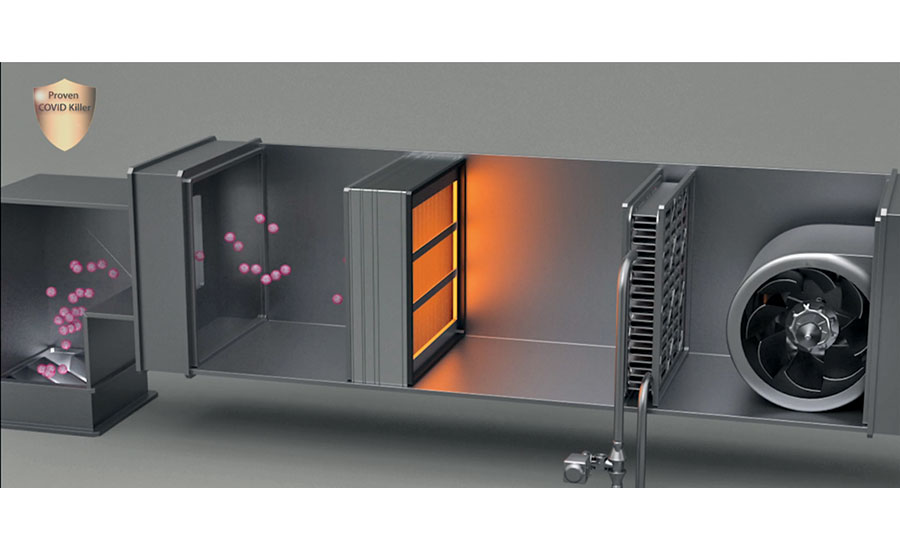The first mobile units of a new air purifier—with a heated nickel-foam filter that traps and zaps more than 99% of the coronavirus and anthrax spores—will be delivered to schools in Texas in time for the beginning of classes, says Integrated Viral Protection, which is commercializing the air filter developed by researchers at the University of Houston. The mobile units are in production in three plants—in the U.S., Canada and Mexico. IVP also is gearing up a custom retrofit service for existing central air systems.
A patent is pending for the heating ventilating and air conditioning (HVAC) system filter, called the Biodefense Indoor Air Protection System, says Garrett K. Peel, a principal of IVP, which is a wholly owned subsidiary of Medistar Corp.
The filter is based on HEPA-filter technology, but it contains an integral heating element that works on the principle of thermal disinfection. Tests at the Galveston National Laboratory determined the filter, heated to 200° C, can trap and deactivate 99.98% of the coronavirus—responsible for COVID-19—as well as 99.9% of anthrax spores that pass through the filter.
The filter also likely destroys other pathogens, including legionella, says Peel, also a co-lead investigator for the University of Houston (UH) research. Researchers did not test specifically for the bacteria that causes Legionnaires’ disease, found in mist expelled from cooling towers. But because the filter is 99.9% effective for anthrax spores, “typically the gold standard for air disinfection,” it also would likely destroy legionella, says Peel.
“It basically can catch and kill spores as small as 100 nanometers or as large as 1,000,” adds Zhifeng Ren, co-lead investigator and director of UH’s Texas Center for Superconductivity. “Nothing can survive biologically” because of the intense heat, Ren says, adding that the virus itself can’t survive temperatures above 70° C.
Gang Chen, a professor of power engineering at the Massachusetts Institute of Technology who reviewed the UH research paper, said in his remarks on the research, “this is very timely work with significant real world implications for the fight against COVID-19.
“Most viruses going through the filter are killed,” said Chen. Though the filter is hot, “the air does not seem to get heated much, suggesting that additional energy consumption is manageable with existing air-conditioning systems.”
However, Chen also said “the mechanism” that kills the virus is “not clear,” and in his opinion, more validation work was “needed.” Still, once that were done, “the technology is simple enough for fast deployment,” he said.
Maintenance and Disposal Safer
The filter distinguishes itself from a HEPA filter in that HEPA filters and other high-efficiency fiber filters only trap the virus, says Ren. The biodefense filter is better because it kills most of the virus, making maintenance and disposal much safer, adds Ren, whose research team collaborated with Monzer Hourani, the mastermind behind the filter concept and CEO of Medistar, a Houston-based medical real estate developer.
For the air tests, the Galveston lab, which is part of the UT Medical Branch, had a virologist prepare samples of the virus. The samples were then aerosolized and run through a prototype filter in a sealed unit, says Slobodan Paessler, the professor of pathology who led the tests.
Filtered air was then tested for the virus and anthrax. “We never discovered any infectious virus,” says Paessler. “The virus is either inactivated or trapped.”
“Because the filter is 99.9% effective for anthrax spores, “the gold standard for air disinfection,” it would likely destroy legionella.”
– Garrett Peel, Principal, IVP
Paessler says he can’t be positive the virus is killed by the filter, but only because the lab did not collect test samples from the filter itself. “But with such high temperatures, I would be surprised if the virus was not deactivated,” he says.
At the high temperatures, the likelihood of virus survival is about the same as the likelihood that “the sky will fall tomorrow,” says Ren.
In IVP’s custom HVAC retrofits, the filter, measuring about 4 ft square or smaller depending on the size of the system, is inserted between the HVAC system’s existing filter and its heating and cooling element. Custom retrofits would cost about $4 per sq ft or $10,000 per ton of cooling, says Peel.
By wiring the filter itself so it is electrically heated, rather than heated from an external source, researchers say they minimized the heat that escapes from the filter, allowing air conditioning to function with minimal strain. “Four centimeters away from the heater, the temperature is that of the environment,” says Peel.
The heat may increase cooling system operating costs 1% or 2%, adds Ren.
Ren suggested using nickel foam because it met several key requirements: It is porous, allowing the flow of air, and it is electrically conductive, which allowed it to be heated. It is also flexible.
The first IVP manufacturing partnerships are with Dust Free LP, based in Royse City, Texas; Engineering CPR, based in Mississauga, Ontario; and Instalaciones Metálicas Sanitarias, S.A. de C.V., based in Tultitlán, Mexico. Production has begun, says Peel.
IVP expects its partners to produce 20,000 mobile units by early next year. He adds that Medistar has invested “millions of dollars” in research and development.
The first units will go to schools in Texas, then Florida and Arizona. Testing of a custom HVAC retrofit is underway at the InterContinental Hotel Houston Medical Center, says Peel.
IVP also is in talks about partnerships with HVAC system makers, but declines to offer details. Major suppliers, including Siemens, Carrier, Johnson Controls and Mitsubishi, were not available or declined to comment on the IVP filter.
William Bahnfleth, chair of the ASHRAE Epidemic Task Force, agrees the filter has promise but also wants more information, especially about its performance. Whether this technology represents an advance over available technologies, such as high-efficiency fiber filters and germicidal ultraviolet air disinfection, will depend on “cost, operating cost, reliability, energy use and scalability,” he says. “It will be interesting to learn more” about its characteristics.





